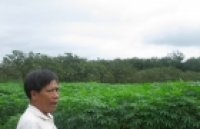| GhABF2, a bZIP transcription factor, confers drought and salinity tolerance in cotton (Gossypium hirsutum L.). |
|
The bZIP transcription factor (TF) act as an important regulator for the abscisic acid (ABA) mediated abiotic stresses signaling pathways in plants. Here, we reported the cloning and characterization of GhABF2, encoding for typical cotton bZIP TF. Overexpression of GhABF2 significantly improved drought and salt stress tolerance both in Arabidopsis and cotton. However, silencing of GhABF2 made transgenic cotton sensitive to PEG osmotic and salt stress. |
|
Liang C, Meng Z, Meng Z, Malik W, Yan R, Lwin KM, Lin F, Wang Y, Sun G, Zhou T, Zhu T, Li J, Jin S, Guo S, Zhang R. Sci Rep. 2016 Oct 7;6:35040. doi: 10.1038/srep35040. AbstractThe bZIP transcription factor (TF) act as an important regulator for the abscisic acid (ABA) mediated abiotic stresses signaling pathways in plants. Here, we reported the cloning and characterization of GhABF2, encoding for typical cotton bZIP TF. Overexpression of GhABF2 significantly improved drought and salt stress tolerance both in Arabidopsis and cotton. However, silencing of GhABF2 made transgenic cotton sensitive to PEG osmotic and salt stress. Expression of GhABF2 was induced by drought and ABA treatments but repressed by high salinity. Transcriptome analysis indicated that GhABF2 increases drought and salt tolerance by regulating genes related to ABA, drought and salt response. The proline contents, activity of superoxide dismutase (SOD) and catalase (CAT) were also significantly increased in GhABF2-overexpression cottons in comparison to wild type after drought and salt treatment. Further, an increase in fiber yield under drought and saline-alkali wetland exhibited the important role of GhABF2 in enhancing the drought and salt tolerance in transgenic lines. In conclusion, manipulation of GhABF2 by biotechnological tools could be a sustainable strategy to deploy drought and salt tolerance in cotton.
See http://www.nature.com/articles/srep35040
Figure 1: Cloning and characterization of GhABF2 and subcellular localization of the GhABF2-GFP fusion protein. (a) Phylogenetic analysis of Group A bZIP TFs in Arabidopsis and rice. The scale bar indicates 0.1 amino acid substitution per site. (b) Comparison of conserved bZIP domains of Group A TFs. Sequences were aligned using ClustalX. Conserved amino acids are highlighted. White letter on black background highlights those amino acids conserved across all of Group A samples (100% conservation), while black letter on gray background highlights amino acids conserved in 60% conservation of the samples. Red arrows indicated the Leucin. (c) Phylogenetic relationship of GhABF2 homologs in plants. AT (Arabidopsis thaliana) OS (Oryza sativa), VV (Vitis vinifera), ST (Solanum tuberosum), POPTRO (Populus trichocarpa), RCOM (Ricinus communis), GM (Glycine max), MT (Medicago truncatula), CS (Cucumis sativus), CA (Cicer arietinum), CICLE (Citrus clementine), TC (Theobroma cacao), CM (Cucumis melo), EG (Eucalyptus grandis), POEUP (Populus euphratica), SI (Sesamum indicum), and JC (Jatropha curcas). The scale bar indicates 0.1 amino acid substitution per site. (d) Subcellular localization of GhABF2-GFP in rice protoplast. Scale bars = 10 μm. |
|
|
|
[ Tin tức liên quan ]___________________________________________________
|


 Curently online :
Curently online :
 Total visitors :
Total visitors :
(33).png)


